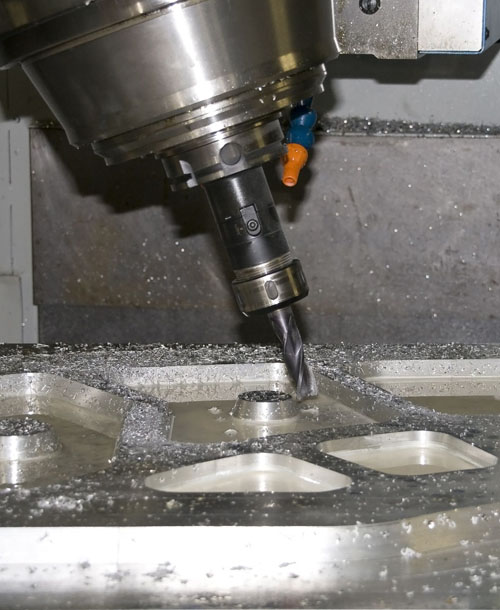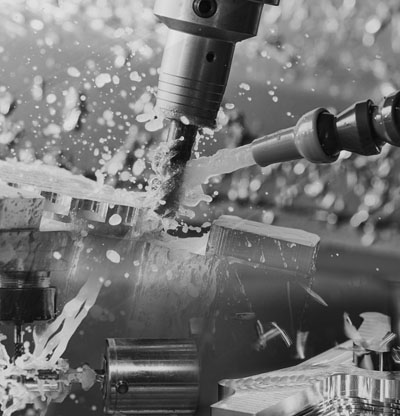With the rapid development of social production and science and technology, mechanical products are becoming more sophisticated and complex, and require frequent modification, especially in the fields of aerospace, shipping, military and other fields, requiring high precision, complex shapes and small batches. Some products require frequent modification or adjustment of equipment, and ordinary machine tools or highly specialized automated machine tools can no longer meet these requirements. In order to solve the above problems, the machining center came into being.
This new type of machine has the advantages of strong adaptability, high machining accuracy, stable machining quality and high efficiency. It integrates various technical achievements such as electronic computer, automatic control, servo drive, precision measurement and new mechanical structure, and can complete the seamless transfer between the various processes of the workpiece through the setting of the processing program. In other words, the CNC machining center can complete a variety of machining processes including milling, drilling, tapping, boring, reaming, etc. on a single device by changing different tools.
We know that the entire processing of the CNC center is controlled by the CNC numerical control system. Generally, the machine tool must not terminate arbitrarily when the processing program is executed. Some problems occur, for example, tool wear and machining allowance are too large, it is not like ordinary processing equipment that can be stopped at will for adjustment.
Therefore, the processing tools it uses are more stringent than ordinary processing equipment. The following briefly introduces the common problems and solutions of CNC centers:

1. The Machined Part Surface Is Not Flat Or Smooth
In the parts processing of CNC milling machine, the finishing of the surface is an important process, and it is also a frequently done process, which requires high surface quality. However, in actual processing, sometimes uneven and uneven surfaces are obtained, which does not meet the requirements.
The main reason for this problem is that during finishing, the performance of the cutting oil cannot meet the processing requirements. When the tool feed speed is too fast, and the vibration caused by the rapid movement of the tool will easily leave an uneven path on the processing surface. Sometimes the tool marks between two adjacent tool paths will have a certain difference, which is caused by the inconsistent cutting direction of the tool. To avoid this problem, you should use the full down milling method and use special cutting oil.
2. The tool marks on the side of the finish milling are too obvious
In the workpiece processing of CNC milling machines, almost every workpiece requires fine milling of the side surface. However, in many cases, there will be too obvious tool marks on the side of finishing milling. This is absolutely not allowed, and it will seriously affect the appearance of the workpiece.
The main reason for this problem is improper selection of the position and parameters of the tool advance and retreat, and the milling methods provided by different processing software will also be different, but they will provide the depth selection of the tool and the parameter selection of the tool.
In addition, when using non-special cutting oil, due to insufficient extreme pressure and anti-wear performance, the oil film breaks instantaneously during the machining process, resulting in scratches on the workpiece. If you want to avoid the above improvement problems, you can make relevant adjustments from four aspects. .
The first is to select the feed point correctly. The second is to add an overlap amount when cutting in the middle. The third is to use full-cut deep processing when finishing the side surface. The fourth is to use special cutting oil.
3. Tool change marks during fine milling
In ordinary processing and high-speed processing, the tool needs to be replaced. If you do not pay attention to the relevant adjustment of the parameters during the tool change operation, obvious traces will appear, which will seriously affect the appearance of the workpiece.
When performing fine milling on the bottom or side surface, it is a common phenomenon that tool marks appear. Many times people think that this is an unavoidable error. In fact, it is completely avoidable. To solve this problem, in the processing of the workpiece, the finishing of the concave corners needs to be replaced with small tools. Because of the force and swing during the processing, it is easy to produce traces of the tool at the corners.

4. After finishing, burrs or sharp edges leaving on the surface or side
Modern precision part processing has higher and higher requirements on the surface, and the appearance of burrs or cracks is not acceptable. If the part is corrected with a file, it will also affect the accuracy and size of the CNC parts. It is used directly after milling, and no further grinding is required. However, in actual production, there will still be a lot of burrs and batches.
To solve this problem, you must pay great attention to the use of tools, and use special tools to ensure sharp cutting.
In addition, it is necessary to plan the tool path well and increase the secondary finishing tool path, which is to process the surface first, then process the side surface, and then process the surface, so as to ensure that there are no burrs and sharp edges, which is useful for workpieces that cannot be polished.
5.Special-shaped precision machining parts finishing
For the finishing of some special-shaped machining parts, the software usually has fitting errors. Sometimes if the calculated error is too large, it will cause deformation of the parts and affect the appearance. To solve this problem, you must start from the software to control the error. This value is relatively reasonable, and it neither affects the calculation speed nor deforms the workpiece.


